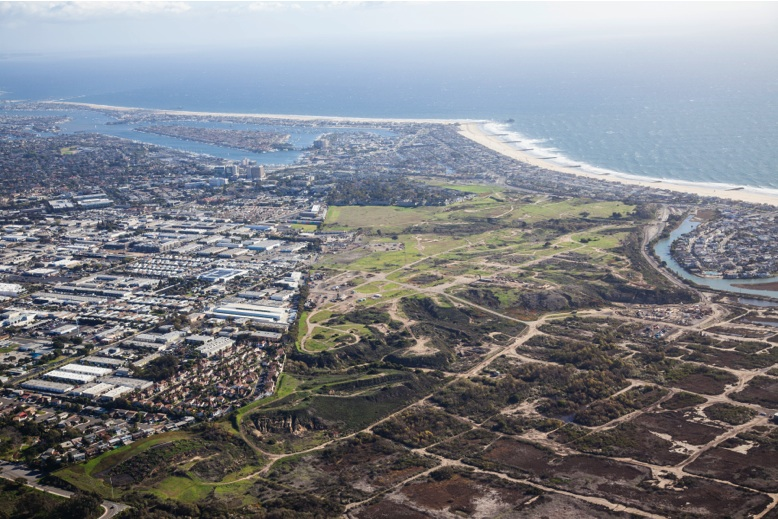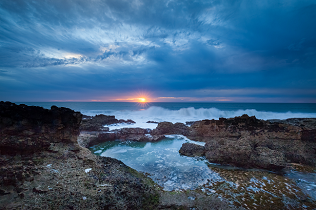
Coastal Commission Test: Protect Banning Ranch
The Aftermath of Two Firings
Community Activists Win Exide Fight
Wolf Hearing

Coastal Commission Test: Protect Banning Ranch
By Kathryn Phillips
A major test of the California Coastal Commission’s willingness to reject powerful developers’ projects on diminishing coastal open space is a little more than a month away.
During its May 11-13 meeting in Newport Beach (at the Newport Beach City Hall), the Commission will decide whether to allow destruction of a rare example of coastal open space in Southern California.
In October, the Coastal Commission staff recommended that the Commission reject a large development project on the 400-acre Banning Ranch in Orange County, the largest privately owned undeveloped open space along the coast in Southern California.
The staff report described the land as home to “an incredibly unique array of coastal species and habitats.” Some of the land has been used as oil drilling sites, but has also been largely off limits to much human traffic, allowing wildlife to take refuge there mostly undisturbed.
“There are very few sites along the southern California coastline with the kind of diverse topography and habitat for wildlife found at this site,” the staff report said. It concluded that the project’s adverse impacts on Banning Ranch’s natural landforms, its biological resources and visual impacts made it inconsistent with the California Coastal Act.
Rather than accept the staff recommendation in October, the Commission gave the development company another chance to revise its proposal and take a second shot at approval.
That second shot will come at the May hearing.
At issue is whether the 12-member commission will permit a developer to build more than 800 homes, a shopping center and hotel on 62 acres of the land. This is reduced in size from the original proposal in October, but still covers much sensitive habitat and will substantially impact what habitat is not developed.
Sierra Club activists and others have organized to oppose the Banning Ranch proposal and support the Coastal Commission staff’s earlier recommendation to reject the permit.
If you want to help protect Banning Ranch, attend the coastal commission hearing in May or send an email to the Commission members urging them to reject the Banning Ranch proposal. That email address is banningranchcomments@coastal.ca.gov.
Until that meeting, you can learn more and keep up on efforts to save Banning Ranch at http://www.savenewportbanningranch.org.
And watch the Coastal Commission website for more information on the May meeting agenda.

By Kathryn Phillips
Recent firings of staff leaders at the California Coastal Commission and the South Coast Air Quality Management District (SCAQMD) prompt a question: What can the legislature do to make sure staff leaders aren’t driven out when their actions offend regulated interests?
The drive to evict Charles Lester from his post as executive director of the Coastal Commission was partly enabled by his quietly assertive effort to enforce the Coastal Act and challenge powerful developers and sister state agencies, including the cash-strapped State Parks system.
Barry Wallerstein’s dismissal, after 18 years leading the SCAQMD, came after the agency began taking a more directed approach to control emissions from oil drilling and oil refineries. The oil industry helped put into position at least one--and probably more--of the new board members who ousted Wallerstein.
The majority that voted Wallerstein out were Republicans. But just a few months earlier, a mix of Democrats and Republicans on the board, led by the legislatively appointed Democratic chair of the board, voted down a critical staff proposal to tighten up a regulation governing refineries, factories and power plants.
At the Coastal Commission, the main board members leading the charge to oust Lester were Democrats appointed by Governor Jerry Brown.
It appears that pushing out environmental defenders is a bipartisan activity in these cases.
One legislative response to these events has been to change or tighten rules to make it harder for regulated entities to overly influence board and commission decisions about personnel. At the legislature, two bills Sierra Club supports would do just that at the Coastal Commission, Asm. Mark Stone’s AB 2002 and Sen. Hannah Beth Jackson’s SB 1190.
Another response is to change the makeup of the board. Asm. Autumn Burke’s AB 2616 proposes to add members to the coastal commission who represent disadvantaged communities. And Senate President Pro Tem de León has said he is considering a bill to add a public health expert and two environmental justice representatives to the board.
All of these bills will face strong opposition at the Capitol from the very interests that helped oust Wallerstein and Lester. We’ll be there to share the other point of view.
Community Activists Win Exide Fight
By Kathryn Phillips
After threatening to weaken environmental review in exchange for state money to clean up legacy lead pollution, the Brown Administration has agreed to let the funding proposal move forward without strings attached.
The administration proposed last month to spend $176 million to jumpstart pollution cleanup at the shuttered Exide lead battery smelting plant in Southern California. Shortly after announcing the funding, word leaked that Governor Brown would also link the funding to an exemption from California Environmental Quality Act (CEQA).
CEQA is the environmental law that requires disclosure of environmental impacts of significant activities. In this case, that would include digging up and moving tons of dirt from neighborhoods surrounding the Exide plant and trucking it to waste dumps.
Community members, environmental justice advocates, environmental groups, and key legislators joined forces to push back against the CEQA exemptions. After a series of tense calls and meetings, the administration relented---for now.
The governor was once quoted in newspapers as saying that he never met a CEQA exemption that he didn’t like. In recent years, it has become nearly routine for Governor Brown and his staff to link positive executive action on environmental issues to CEQA exemptions.

The Fish and Game Commission next week will consider a ban on lethal trapping and night-hunting of other animals in the wolf recovery zone.
Be there to speak for the wolves.
Who: Fish and Game Commission:
What: Consider the possible ban on lethal trapping and night-hunting in the wolf recovery zone.
When: APRIL 14, 2016, 8:00 A.M.
Where: Flamingo Conference Resort & Spa, 2777 Fourth Street, Santa Rosa, CA 95405
Specific state regulations are necessary to protect gray wolves in the state from one of the greatest threats to their recovery, the accidental killing of gray wolves.
Ask the Commission to adopt a ban on night-time hunting and lethal trapping of nongame and furbearer species within the range of the gray wolf.
Follow Us:
  |
Thank you for being a part of our work! You may securely donate online or by sending a check to Sierra Club California at 909 12th Street, Suite 202, Sacramento, CA 95814.
